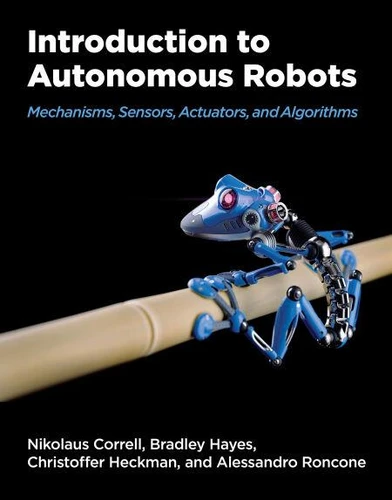Introduction to Autonomous Robots. Mechanisms, Sensors, Actuators, and Algorithms
Par : , , ,Formats :
Disponible dans votre compte client Decitre ou Furet du Nord dès validation de votre commande. Le format ePub protégé est :
- Compatible avec une lecture sur My Vivlio (smartphone, tablette, ordinateur)
- Compatible avec une lecture sur liseuses Vivlio
- Pour les liseuses autres que Vivlio, vous devez utiliser le logiciel Adobe Digital Edition. Non compatible avec la lecture sur les liseuses Kindle, Remarkable et Sony
- Non compatible avec un achat hors France métropolitaine
 , qui est-ce ?
, qui est-ce ?Notre partenaire de plateforme de lecture numérique où vous retrouverez l'ensemble de vos ebooks gratuitement
Pour en savoir plus sur nos ebooks, consultez notre aide en ligne ici
- Nombre de pages288
- FormatePub
- ISBN978-0-262-37294-7
- EAN9780262372947
- Date de parution20/12/2022
- Protection num.Adobe DRM
- Taille14 Mo
- Infos supplémentairesepub
- ÉditeurThe MIT Press
Résumé
A comprehensive introduction to the field of autonomous robotics aimed at upper-level undergraduates and offering additional online resources. Textbooks that provide a broad algorithmic perspective on the mechanics and dynamics of robots almost unfailingly serve students at the graduate level. Introduction to Autonomous Robots offers a much-needed resource for teaching third- and fourth-year undergraduates the computational fundamentals behind the design and control of autonomous robots.
The authors use a class-tested and accessible approach to present progressive, step-by-step development concepts, alongside a wide range of real-world examples and fundamental concepts in mechanisms, sensing and actuation, computation, and uncertainty. Throughout, the authors balance the impact of hardware (mechanism, sensor, actuator) and software (algorithms) in teaching robot autonomy. Features: Rigorous and tested in the classroom Written for engineering and computer science undergraduates with a sophomore-level understanding of linear algebra, probability theory, trigonometry, and statistics QR codes in the text guide readers to online lecture videos and animations Topics include: basic concepts in robotic mechanisms like locomotion and grasping, plus the resulting forces; operation principles of sensors and actuators; basic algorithms for vision and feature detection; an introduction to artificial neural networks, including convolutional and recurrent variants Extensive appendices focus on project-based curricula, pertinent areas of mathematics, backpropagation, writing a research paper, and other topics A growing library of exercises in an open-source, platform-independent simulation (Webots)
The authors use a class-tested and accessible approach to present progressive, step-by-step development concepts, alongside a wide range of real-world examples and fundamental concepts in mechanisms, sensing and actuation, computation, and uncertainty. Throughout, the authors balance the impact of hardware (mechanism, sensor, actuator) and software (algorithms) in teaching robot autonomy. Features: Rigorous and tested in the classroom Written for engineering and computer science undergraduates with a sophomore-level understanding of linear algebra, probability theory, trigonometry, and statistics QR codes in the text guide readers to online lecture videos and animations Topics include: basic concepts in robotic mechanisms like locomotion and grasping, plus the resulting forces; operation principles of sensors and actuators; basic algorithms for vision and feature detection; an introduction to artificial neural networks, including convolutional and recurrent variants Extensive appendices focus on project-based curricula, pertinent areas of mathematics, backpropagation, writing a research paper, and other topics A growing library of exercises in an open-source, platform-independent simulation (Webots)
A comprehensive introduction to the field of autonomous robotics aimed at upper-level undergraduates and offering additional online resources. Textbooks that provide a broad algorithmic perspective on the mechanics and dynamics of robots almost unfailingly serve students at the graduate level. Introduction to Autonomous Robots offers a much-needed resource for teaching third- and fourth-year undergraduates the computational fundamentals behind the design and control of autonomous robots.
The authors use a class-tested and accessible approach to present progressive, step-by-step development concepts, alongside a wide range of real-world examples and fundamental concepts in mechanisms, sensing and actuation, computation, and uncertainty. Throughout, the authors balance the impact of hardware (mechanism, sensor, actuator) and software (algorithms) in teaching robot autonomy. Features: Rigorous and tested in the classroom Written for engineering and computer science undergraduates with a sophomore-level understanding of linear algebra, probability theory, trigonometry, and statistics QR codes in the text guide readers to online lecture videos and animations Topics include: basic concepts in robotic mechanisms like locomotion and grasping, plus the resulting forces; operation principles of sensors and actuators; basic algorithms for vision and feature detection; an introduction to artificial neural networks, including convolutional and recurrent variants Extensive appendices focus on project-based curricula, pertinent areas of mathematics, backpropagation, writing a research paper, and other topics A growing library of exercises in an open-source, platform-independent simulation (Webots)
The authors use a class-tested and accessible approach to present progressive, step-by-step development concepts, alongside a wide range of real-world examples and fundamental concepts in mechanisms, sensing and actuation, computation, and uncertainty. Throughout, the authors balance the impact of hardware (mechanism, sensor, actuator) and software (algorithms) in teaching robot autonomy. Features: Rigorous and tested in the classroom Written for engineering and computer science undergraduates with a sophomore-level understanding of linear algebra, probability theory, trigonometry, and statistics QR codes in the text guide readers to online lecture videos and animations Topics include: basic concepts in robotic mechanisms like locomotion and grasping, plus the resulting forces; operation principles of sensors and actuators; basic algorithms for vision and feature detection; an introduction to artificial neural networks, including convolutional and recurrent variants Extensive appendices focus on project-based curricula, pertinent areas of mathematics, backpropagation, writing a research paper, and other topics A growing library of exercises in an open-source, platform-independent simulation (Webots)



